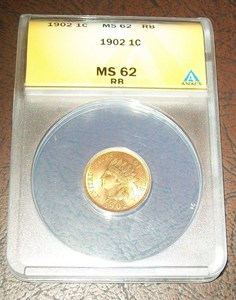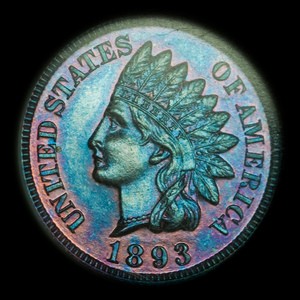 Any coin collector who has focused on Indian Head cents has noticed not all Indian Head cents are the same — especially if those Indian pennies are uncirculated.
Any coin collector who has focused on Indian Head cents has noticed not all Indian Head cents are the same — especially if those Indian pennies are uncirculated.
Not sure what I’m talking about?
Check out a coin dealer’s store or even eBay’s current crop of mint-state Indian Head cents to look at the many colors of Indian Head cents on the market.
Many Indian Head cents are red, others are brown, and a wide selection are a mixture of brown and red colors.
What causes these different colors? Why are the colors important? How can the colors even affect the value of your coin?
Brown, Red/Brown, And Red: Why Color Matters
 While you may be able to determine red from brown on the a color palette of paints, trying to pick out red from brown, and especially red/brown from red and brown can be a little difficult.
While you may be able to determine red from brown on the a color palette of paints, trying to pick out red from brown, and especially red/brown from red and brown can be a little difficult.
After all, as you may have realized by now, coin grading is more of an art than a science.
What does that mean to you?
Your Red Indian Head cent may be somebody else’s Red/Brown Indian cent!
But you might still be asking yourself why the color of Indian Head cents even matters in the scheme of coin collecting. Well, quite simply, it all comes down to eye appeal and value.
Red Indian Head Cents
In general terms, the more red on an Indian Head cent, the more value the coin has. This is largely because a Red (or RD) Indian Head cent looks almost like it did when it was still new and fresh from the U.S. Mint.
Red, also, is one of the most challenging colors to find on an old copper coin because copper tends to turn darker or greener over the years. So, finding a naturally red, old copper coin is something whcih is quite difficult. And, therefore, a primary reason why red is such a desirable color on Indian Head cents (and any old copper coins).
However, as you may have guessed, a coin with a sought-after color also comes with a high price tag. In fact, depending on the actual date and Indian Head penny, a Red Indian Head cent can cost between 2 and 10 times more than a Brown or Red/Brown example!
Brown Indian Head Cents
Brown Indian Head cents come in on the opposite end of the color scale. If Red Indian Head cents are the least common, then Brown (or BN) Indian pennies are among the most common.
Most old copper coins, as they age, tend to turn brown or green. While you may assume all uncirculated pennies look bright and shiny, the truth is that many Indian Head cents without even a smudge of wear look dull brown.
While brown is the generally the most common color category for Indian cents, not all Brown Indian cents are the same. A nice, deep, chocolate brown color is often the most desirable shade of brown for any brown-colored Indian cent (either circulated or uncirculated).
A Brown Indian Head cent without spots is by far more valued by coin collectors than a coin with spots.
Also, it’s very important for brown Indian Head cents to have an even color. Any Indian cent — even brown ones — tend to be less valuable if the color is splotchy than if it looks even.
However, as with any toned coin, every coin collector has their own opinion as to what the most desirable color patterns are. Some people actually like splotchy or mottled toning and will pay for this if they see such a coin in a coin shop. In general, though, it’s still wise to look for coins with nice, even color than spotty or splotchy color, as you’ll find most coin collectors tend to desire coins with even color rather than uneven color.
Red/Brown Indian Cents
Indian cents that seem to have color traits lending to both red and brown are dubbed Red/Brown (or RB) Indian cents. While some Brown Indian cents may have the smallest trace of red and still be Brown, some Red Indian cents may be a bit brown in some crevices and still be Red, Indian cents that show a mixture of red and brown colors are, appropriately, called Red/Brown Indian cents.
A Red/Brown Indian cent may show some significant areas of red near the letters and around the date and be brown across the fields (the flat area of a coin).
Or, you may find a Red/Brown Indian cent that is has some red patches in the field and areas of brown, too. A Red/Brown Indian cent may even be nearly full red on one side and brown on the other (if the coin was, for example, protected on one side but left to the elements on the other).
Indian Head cents with an even color between full red and full brown may also be called Red/Brown.
Usually, the combination of where the red and brown are seen on the coin are less important than how much red and brown are actually on the coin. As everybody grades coins differently, providing you a hard-and-fast rule here can be a little tricky, but any Indian cent that isn’t predominately red or brown can be safely classified as Red/Brown.
Any Indian cents that seem to show more than a simple trace of red may also be categorized as Red/Brown.
The same goes for the other end of the Indian Head penny color spectrum; you’ll find that many Indian cents with vast areas of red but more than a trace of brown also being labeled Red/Brown.
A Note On Artificial Toning
Don’t go trying to change the color of your coins to make them look more desirable! Most coin collectors and certification services can quickly pick out what coins have been dipped in chemicals or artificially toned. Such coins are worth less than naturally toned coins.
Any coins that have been evidently dipped or toned through artificial means can be harder to sell and are often rejected by seasoned numismatists.




